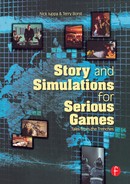30
The Future: The Role of Story
IMMERSIVE DISTANCE LEARNING EXPERIENCES
Higher education has been in a “steady state” phase for at least a generation, with few new institutions, public or private, opening for business. Distance learning, however, is growing by leaps and bounds, thanks in part to the widespread deployment and availability of digital technologies and delivery systems.
Environments like Virtual Harlem, a 3D recreation of 1920–1930s Harlem, intended to educate students about the Harlem Renaissance, are being delivered to remote classrooms. This book has made the case that these environments and experiences will be enriched further when story components, and even fullblown story narratives, are added to multimedia and 3D distance learning experiences. While we can build navigable 3D environments with increasing ease, these environments become little more than “open house” or diorama experiences without a compelling throughline and personal stakes that will motivate users to fully explore and gain knowledge about the space.
The same is true for distance learning experiences that rely more on delivery of e-mails, documents, instant messaging, websites, slideshows, and audio and video snippets. The disparateness of these separate media cry out for some unifying force, a spine or throughline that will create a shared imaginative world, hiding some of the seams of this mélange of data delivery. Alternate reality games suggest one methodology for importing story into these experiences: the stories can even provoke more active user interactions, either with other users or with real-world environments. By knitting together the virtual and the physical worlds, a greater sense of immersiveness will be achieved.
As distance learning experiences become more pervasive at all levels of education and training, the addition of story spaces and story narratives will be some of the primary elements differentiating a perfunctory product from a superior product.
Figure 30.1 Virtual Harlem allows students to walk through the streets of Harlem in the 1920–1930s and learn more about the context of the literature they are studying. Reproduced with permission from Bryan W. Carter.
ONLINE COLLABORATIVE GAMES AND SIMULATIONS
As we’ve discussed in Chapter Twenty-nine, story narratives and story worlds seem to work very well in collaborative environments. The story world can create a safe environment, adding both meaning and desire to users thrown together and being asked to work with one another to achieve common objectives.
Creating a shared narrative framework helps users who are otherwise strangers come together. Think about fandom for a particular sports team. Successful fandom is generated because the sports team creates a shared narrative: they may be a scrappy, underdog team mirroring the scrappy, underdog narrative of a city like Pittsburgh; or a sleek, glamorous team mirroring the sleek, glamorous narrative of a city like Los Angeles or New York. In turn, this shared narrative helps fans connect with each other and give more of themselves to the “alternate reality” created (e.g., fans will paint themselves outrageously and otherwise “act out” without fear of social retribution; indeed, fandom behavior is encouraged by other fans).
The shared story world also encourages users to learn from each other, accelerating the rolling out of pedagogy and its mastery. Left to their own devices, with no shared narrative, people have a more difficult time connecting and collaborating. We see this behavior all the time, in elevators, in a line at the post office, or in the workplace (in our first days on a new job). However, under the umbrella of a story experience, the usual social barriers that stand between people dissipate. Users are more willing to collaborate with fellow users and to tutor newcomers.
Most job functions and workplace environments require collaboration and team building. As jobs get more complex and as labor costs for hands-on training continue to rise, training in these areas is likely to lean more heavily on simulations to smooth the entry of new employees and upgrade the skills of veterans. Both small- and large-scale stories will aid in the delivery of pedagogy in these contexts.
STORY-DRIVEN MASSIVELY MULTIPLAYER ONLINE GAMES
In the commercial arena, MMOGs have combined collaborative and combative gameplay, and as we’ve observed in Chapter Twenty-Nine, the importance of story in MMOGs has sometimes varied, not because it’s unimportant (just the opposite) but because it’s been hard to calibrate in a satisfying way for all players.
However, as cinematic (i.e., Hollywood) stories have increasingly suffused with videogames, serving to further expand the audience, so too can we expect commercial MMOGs to lean more on larger, continuing stories, in a bid to expand the user base.
The serious games community is now looking to deploy MMOG environments. As we’ve discussed, the inclusion of story narrative speeds the delivery of pedagogy and creates greater immersion for an environment. Development on MMOGs for the medical profession, first responders, and the legal profession is already underway. These MMOGs will create story worlds with very specific goals and conflicts, and perhaps, with a greater degree of closure than commercial MMOGs ever attempt (because it is against their economic interests to do so).
LOCATION-BASED FULL-SENSORY SIMULATIONS (VIRTUAL REALITY)
Location-based story-driven simulations already exist; for the most part, they’re theme park rides (most of us have experienced at least one). If we think about a ride like Indiana Jones or Pirates of the Caribbean at Disneyland, we realize that these are classic full-sensory, virtual reality simulation environments rich in story narrative.
The Indiana Jones ride relies hugely on the backstory of the films; the classic Pirates of the Caribbean ride creates a complete story arc, as the audience is plunged downward into a virtual pirate-land-of-the-dead. The narrative then flashes back to the lives and typical times of the pirates, as they defeat an enemy force, pillage a seaside town, and enjoy their spoils. It’s not surprising that the theme park ride was rich enough in content to serve as the springboard for a blockbuster film franchise.
Significantly, these theme park rides have been passive, movie-like experiences until recently. One of Disney’s most popular current attractions, Buzz Lightyear’s Astro Blasters adventure, adds a first-person shooter component to the ride, while relying on the Toy Story films for backstory.
Location-based environments are hugely expensive, of course; it’s no coincidence that huge media giants like Disney and GE/Universal are primary players in this arena. Most pedagogical entities don’t have the budgets or facilities to begin designing serious games or training simulations with this kind of size and scope. It’s much cheaper to build a virtual 3D environment on a display screen.
That said, there is clearly tremendous power in the experience of a full-scale physical, sensory simulation; theme parks make huge revenues for a reason. Location-based environments may be the last frontier for pedagogically driven simulations. Already, the US Army has been building full-sensory, story-driven environments for soldier training. Leading American universities are experimenting with similar environments.
Although simple, full-sensory simulations like paintball can be compelling for user-participants, full-sensory simulations containing educational experiences will need much more context and narrative to motivate and guide users. Story development and execution will be a crucial component in the successful deployment of location-based, full-sensory simulations.
KEEPING TRACK OF THE EVOLUTION
Numerous organizations, conferences, and Websites now exist to track some of the progress and proliferation of serious games.
• |
Games for Health, www.gamesforhealth.org |
• |
Games for Change, www.gamesforchange.org |
• |
Serious Games Initiative, www.seriousgames.org |
• |
Social Impact Games, www.socialimpactgames.com |
• |
The Education Arcade, www.educationarcade.org |
SUMMARY
As the novelty of immersive distance learning, collaborative simulations, and massively multiplayer games wears off, users will increasingly demand good stories in the serious games and simulations they participate in. Given the ubiquity of media, the good story is what will draw greater interest and involvement. We see this in television (the reason American Idol and Survivor are popular is because of the storylines they contrive), in sports (the Lakers were the most popular NBA team for years because of the Kobe-Shaq melodrama), and in videogames (Halo, Half-Life, etc.). Simulation designers and training developers must not overlook the quality of the story in the pedagogical worlds they create.

